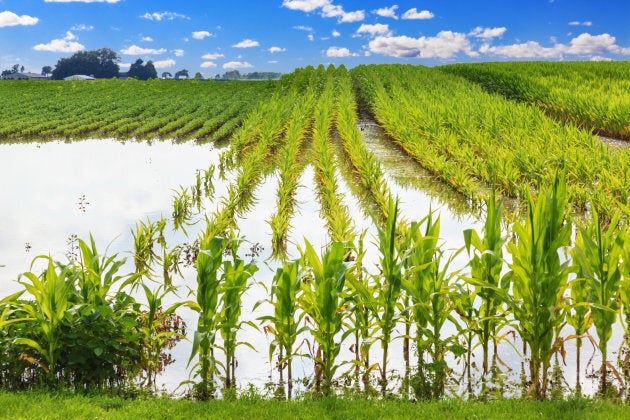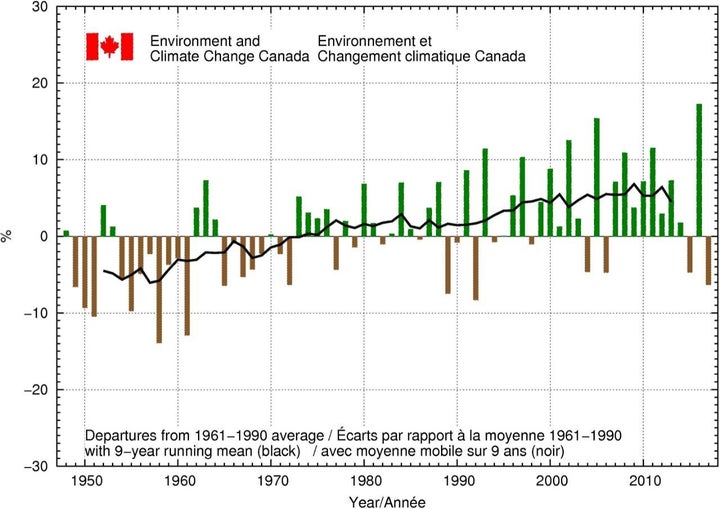I recently attended a course on geopolitics at a Canadian university, where the professor, a highly accomplished and well-published geographer, was delivering an overview of the geopolitical implications of climate change. A multi-colored global map was displayed, with the familiar patterns of Western countries largely in shades of blue-green, with most areas of the Global South in red, maroon and black.
The professor explained that this was a map depicting projections of global food production based on current climate trends. To my utter dismay, the professor stated (I paraphrase), "As you can see, at least in the short term, Canada is actually set to be a net beneficiary of climate change."
Wait, what?
To be fair, climate science isn't his area, so naturally, I challenged him on this. I told him that his map has entirely ignored extreme weather. Last spring saw record flooding, followed by a summer that saw continued record precipitation. Last summer's weather, described by an Environment Canada researcher as a "monsoon season," devastated crops. Put simply, too much water kills crops, which means floods, mold, disease, disorder and general pestilence.

The professor seemed unconvinced, which does not concern me. But what does concern me is that if a professor of geography can display such a misguided grasp of basic climate science, what do we expect from our politicians and policy-makers? Most of the people making the decisions that affect our future have, comparatively speaking, no exposure to the science behind climate change.
This may explain why, if a recent TVO report is to be believed, some climate-related truth bombs recently dropped by the former Ontario Environment Commissioner left a room full of municipal and provincial forecasters and emergency managers sitting in stunned silence.
The news that hit the crowd of people who plan our cities like a tsunami was that "...climate change has altered the fundamentals of the weather system. All of our old predictions — which were used to build thousands of kilometers of road, drainage pipe, and sewers — are inadequate." And they aren't just "sort of" inadequate: we are hopelessly unprepared.
Our seasons are getting wetter, and when the wet weather comes, it sticks around much longer.
To put things into perspective, in 1954 Toronto was hit by Hurricane Hazel, a storm so devastating they created the Toronto and Region Conservation Authority, and caused Toronto to completely rethink its planning, incorporating more green space, reducing impermeable surfaces and building new developments based on a 500-year flood model.
Most municipalities use a 100-year storm scenario that involves 99.8 millimeters of rain in 10 hours. Hazel, which produced 200 millimeters of rain over 48 hours, is being outdone by increasingly common freak "supercell" storms, like the Burlington, Ontario flood of 2014, which saw a shocking 191 millimeters of rain in just 10 hours.
Based on current projections, these kinds of extreme events are likely to increase. Our seasons are getting wetter, and when the wet weather comes, it sticks around much longer. Not only is Ontario's infrastructure not up to the task, we don't have the cash to change that reality.

The burden of these issues falls disproportionately on municipalities, who must deal firsthand with many of the real-time effects of climate change. Ottawa, where I call home, is facing these issues, with more flooding being predicted for this spring. Ottawa has recently invested over $2.1 Billion in light rail and has a great many number of pressing spending priorities, but also has over 2,500 kilometres of storm sewers, 70 per cent of the city does not have in-situ stormwater management, like holding ponds or reservoirs, and Ottawa's soil is largely impermeable clay. When it rains in Ottawa, virtually all the water ends up in its rivers.
The city has moved to address combined sewer overflows, which stops raw sewage from spilling into the river, and is taking some tentative steps toward incorporating Green Infrastructure policies that seek to use a mix of measures to manage stormwater at the source. However, the city is taking a "test case" approach to Green Infrastructure, despite there already being a robust body of local evidence of substantial benefit. Our policymakers either lack the political will to lead on climate resilience, or perhaps they simply don't fully understand the urgency.
It's becoming increasingly apparent that cities will play a critical role in the fight against climate change. While most jurisdictions have robust policies, Canada has fallen behind in adopting Green Infrastructure, hampered by previous government's anti-climate action agenda that left climate resilience policy piecemealed, unfocused and lacking any hard targets or goals.
More from HuffPost Canada:
- Want Resilient Cities? Try A National Policy On Green Infrastructure
- Shift To Green Economy Would Create 4 Million Canadian Jobs: Report
- We Need A Green Economy And Climate Agenda For All Canadians
Green Infrastructure is a great place to start because, as already demonstrated by other North American cities, with the right mix of incentives, education and capital projects, it can provide significant in-situ stormwater mitigation, often for less initial costs, and much better return on investment than traditional grey infrastructure.
Another way Green Infrastructure can do more for less is through community engagement, which NGO's like Ecology Ottawa are doing by engaging both policy-makers and communities on the issue and seeking community-led solutions.
Green Infrastructure can include planting trees, using rain barrels, developing parks, green spaces and community gardens, and beautification and naturalization of urban landscapes. It's a great way to engage communities on how to make happier, healthier livable cities that are hardened from risk, and where families and businesses flourish. It's time to listen to the climate science, and for our leaders to try Green Infrastructure on for size.
Also on HuffPost: